GOING FOR CAEN
At the end of D-Day, 6th June 1944, around 155,000 men were landed in Normandy.
And a decent bridgehead was built. Omaha Beach was proven the hardest nut to crack, but over there, also
a bridgehead was created by the 1st Infantry Division and the 29th Infantry Division. The British and
Canadian troops were at least 10 kilometers inland, but one of the targets, taking Caen, was not done.
Now Caen was still in German hands, another strategy was employed.

(left) Montgomery confers with Eisenhower (middle) and
Bradley
The troops under Montgomery should, according to Lt-Gen. Omar Bradley, commander of the First US
Army, consolidate and draw German troops, while the Americans would break out in a large detour towards
Paris. Bayeux fell in hands of the British 50th Infantry Division on D-Day+1, and Montgomery was
convinced that Caen could be taken in a couple of days. The 50th
Infantry Division had landed on 6 June and was reinforced the next day by the 7th Armoured Division.
Together they formed the so called ‘ex-Desert Rats’, and were the most experienced troops Montgomery
had in Normandy. Biggest problem for the 7th Armoured was their armour, it was in many cases inferior
to the German tanks. There were Sherman Firefly tanks (with the 17 pounder gun), but in small quantities.
And their direct adversary was the Panzer Lehr Division, with an addition of the formidable 101st Schwere
SS Panzer Abteilung, with three companys of each fourteen Tiger tanks (with the notation that some
were broken down, or put out of action by the Allied airforce).
 
Emblems of the 50th Infantry- and the 7th Armoured Division
With the 50th (Northumbrian) Infantry Division, Operation Perch would start. After the taking
of Bayeux, the division had to secure the route towards Tilly-sur-Seulles. After that, they had to make
a breakthrough through the Panzer Lehr Division. This attack would get the support of a battleship and
two cruisers, plus airsupport. Once a new bridgehead was consolidated, the
7th Armoured would make a dash towards Villers-Bocage and then via Évercy on towards Caen. This last leg
would get support from para’s of the 1st Airborne Division. But Air Chief Marshal
Sir Trafford Leigh-Mallory refused the transport planes because it would be very hazardous for the pilots
to operate in this heavenly defended area. Montgomery was very angry, but would later admit that the decision
Leigh-Mallory took was the right one. Bayeux was, as mentioned before, easely taken, but after that,
the 50th Division got stuck in the Bocage, the infamous Normandy hedges. In these hedges the Panzer Lehr
could hide his tanks and anti-tank guns.
Montgomery decided that the 7th Armoured should make a big hook towards Villers-Bocage. In the meantime
the 7th Armoured was preparing itself for a breakout, Panzer Group West was planning an attack. This
planning meant that German tanks were moved during daytime. This brought heavy casualties to the Germans,
because of the non-stop attacks by the Allied fighterbombers.

...On their way to the Normandy invasion grounds,
Tiger '131' under the command of SS-Untersturmführer Walter Hahn
in Morgny,
(101st Schwere SS Panzer Abteilung on 7 June 1944, Then and Now)

On 10 June a big surprise came in, when it was learned through the code breakers of Ultra, that an
airstrike against the headquarters of Panzer Gruppe West, under command of General Geyr von Schweppenburg,
could take place. Good placement of rockets and bombs destroyed the communication centre in the castle near
La Caine. Besides the important damage, 18 German officers were killed, among them Generalmajor Ritter
von Dawans. Many were wounded, among them Von Schweppenburg.

The castle La Caine is restored to her old glory
(in the backyard are still German relics to be found
like steel wires against intruders and were mines once were placed)
On 10 June, also the breakout was commenced by the 7th Armoured Division towards Tilly-sur-Seulles.
First in line was the 22nd Armoured Brigade with the 4th County of London Yeomanry (CLY), they moved
from Bayeux on the main road. Second in line was the 5th Royal Tank Regiment (RTR). The last column went
west and after Blary, they went south. The two units were very close and were stopped in the German defense.
Not only Germans claimed British tanks as casualties, also friendly fire from the 8th Armoured Brigade
destroyed two tanks from the 4th CLY. This was due to the bad communications between the moving units.
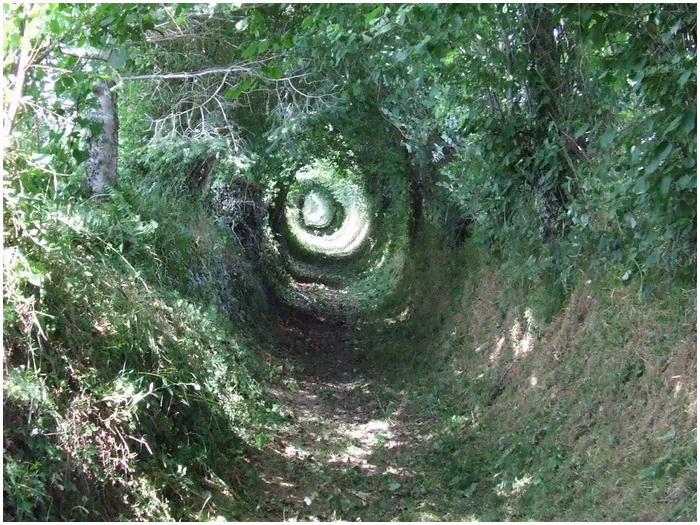
This is the real infamous 'Bocage', but it is now almost
gone,
because of the enlargement of the roads
On 11 June the column headed out again, but were stopped again when the germans went into an attack.
Within moments 10 Sherman tanks were shot up by the German Panther and Panzer IV tanks. Also four
selfpropelled guns and a M10 were destroyed. The British destroyed one German tank. In the afternoon XXX Corps
decided, that the 56th Infantry Brigade should take over the attack of the 22nd Armoured Brigade.
The last should move against Lingèvres. With this decision, the 4th CLY came under command of the 56th
Infantry Brigade and the 2nd Essex under command of the 22nd Armoured Brigade. The next day, the 131st
Infantry Brigade, belonging to the 7th Armoured Division would move through the 56th Infantry Brigade
and take up positions at the front. 1st/5th Battalion, The Queen’s Royal Regiment of the 131st I.Br.
took up positions west of Tilly-sur-Seulles. On 12 June, 1st/6th Queen’s van de 131st I.Br. had taken up
positions south of Foliot. The other battalion, the 1st/7th Queen’s, took up positions the same day, north
of Ste-Honorine-de-Ducy. Slow but steady, the British were in position to break out towards Villers-Bocage.
The main force would move over the D99, with jump off point, Saint-Paul-du-Vernay. To reinforce these troops,
the road between Tilly-sur-Seulles and Saint-Paul-du-Vernay, the D13, should be secured. This task was given
to two battalions of the Durham Light Infantry, the 6th and 9th DLI, with support of a regiment tanks of the
4th/7th Royal Dragoon Guards, 8th Armoured Brigade. These units were sent south, on two separate routes
towards Lingèvres.
Tour to
Lingèvres &
Villers-Bocage
You may start this tour from Bayeux or from the town of Tilly-sur-Seulles. Head for
Lingèvres, on the D13 (halfway Tilly-sur-Seulles and Saint-Paul-du-Vernay). Lingèvres was
the scene of heavy fighting. Park your vehicle near the church. On a wall of the church a
plaque remembers the fighting that took place around here. Lingèvres would be attacked on
14 June via two roads from the north, the D33A (the 9th DLI) and the D187 (the 6th DLI from
Les Verrières). In the afternoon, at the headquarters of the 151st Infantry Brigade, Lt-Col
Wood had his doubts to make an attack during the daytime, because of the high casualties it
could bring, but his objections were pushed aside. The pressure was that great to break out
of the bridgehead, that speed was essential. On 14 June, at 10.00 hours, Typhoon fighterbombers
shot up the edge of the woods, north of Lingèvres. Also artillery shells from the 5th Army Group
Royal Artillery, with support of an American battalion were shot at the enemy positions.
 
Emblems of the Durham Light Infantry and the
4th/7th Dragoon Guards
Around 10.15 hours a steady march over a wide front began when the 9th DLI moved down
the D33a. With the bayonet stuck onto the rifle, it looked similar like an attack in the
First World War. On the flanks drove the tanks of the 4th/7th Dragoon Guards. When the
British were near the forest, the Germans opened up on them. It was a slaughter, A Company
on the left lost all her officers, including the forward observation officers. They were
essential to direct the artillery.
B Company took over the lead, but lost also many men. C and D Company on the right, had a
little less opposition. Lt-Col Wood ordered Major John Mogg to push with both companies,
while he would try if A and C Company could make a hook and support C en D. It was the last
radio call from Wood, short after the message his vehicle was hit by a mortar shell, and he was
killed. Major Mogg took over his duties. The attack went ahead, but the losses mounted. But the
edge of the forest was finally taken and troops went into the village of Lingèvres.
Around noon, the 9th Durham Light Infantry, with the support of tanks of the 4th/7th Dragoon
Guards, went into Lingèvres and started to clean it from Germans. The tanks of 4th Troop of A
Squadron consisted of three Sherman 75mm and one Sherman Firefly with its 17-pounder gun.
The original Firefly of 4th Troop, had lost his way and another one, under command of Sergeant
Wilf Harris, was added to 4th Troop. Harris was ordered in Lingèvres to watch out for two Panther
tanks that were prowling in the neighbourhood. Harris moved his Firefly to the east of the village,
on the D13, looking towards Tilly-sur-Seulles.

Sergeant Wilf Harris
Two other Sherman tanks, with the standard 75mm gun, were positioned at the other crossings,
to the west and south. Commander of A Squadron, Lt. Alastair Morrison positioned his tank near
the church tower. Corporal Johnson his Sherman was placed at the T-junction looking
towards Longraye. There was yet another Sherman tank, an OP (Observation Post). This one had no
cannon (which was replaced by a wooden one) so more room was created for a map table and radio’s.
From this PO, the forward observation officer, Major Swann, could call in artillery if the Germans
were counterattacking.

14 June, 1944; Lingèvres and the positions of
the tanks:
1. First position of Harris his Firefly
2. The first and second destroyed Panther
3. Harris his next position
4, 5 & 6: position of the other crippled Panthers
7. The position (blue square) of Cpl. Johnson his Sherman tank
(picture; Google Earth)
Ten minutes after Harris took up his position with his Firefly, he noticed a Sherman tank
with two Panthers following him. Realising the Sherman (German loot?) was a decoy and let him
pass to the north. He wanted the Panthers. When the first was at a range of 400 meters, gunner
Mackillop shot a shell into it. With a loud bang the Panther completely destroyed. The next shot
crippled the second Panther. It could not move anymore, but it’s fearsome gun was still in working order.

Looking towards Tilly-sur-Seulles on the D13;
global at the position
of the Firefly from Harris
(Where the car is driving, the Panthers emerged from the right)
Harris pulled back behind a small farm. Major Mogg personaly led a PIAT unit, a soldier and a
sergeant, to the Panther. When they were 15 meters from the German tank, Mogg gave the order to
fire the PIAT. But both men had no idea how the weapon operated, so Mogg himself destroyed the
Panther with the PIAT. Around 12.30 hours another Panther was approaching from Tilly-sur-Seulles.
Harris was still in position near the farm and let the Panther pass the ‘killed’ Panther. Again
the first shot destroyed the Panther in a ball of fire.
Another group had discoverd a Panther in a shed near the road leading towards Longraye (D187
to the south). But their PIAT refused and they had to observe how the Panther was moving of to the south.
A short while later the 75mm Sherman from Cpl. Johnson, who was guarding the road towards
Longraye, was destroyed with a single shell (in the picture below is evidence of a second hit in the front of the
transmission). Only one of the crew was unhurt, the others wounded or killed.
Cpl. Johnson died the next day of his wounds.
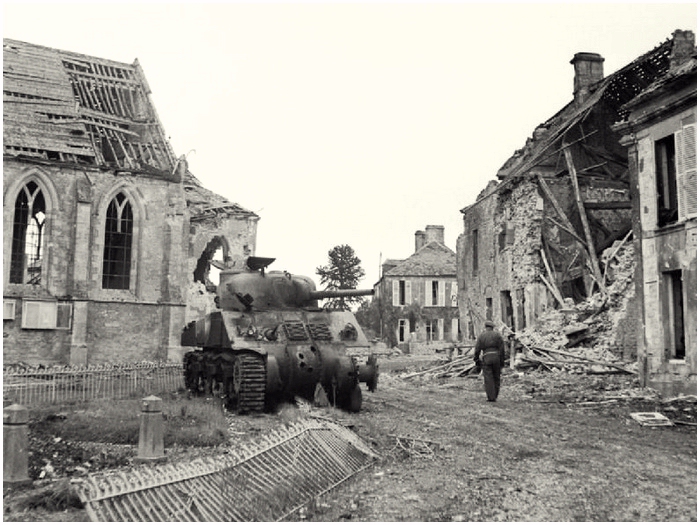
The Sherman tank from Cpl. Johnson burned out, pointing
towards Longraye
Notice the holes from German shells in front of the hull near the transmission
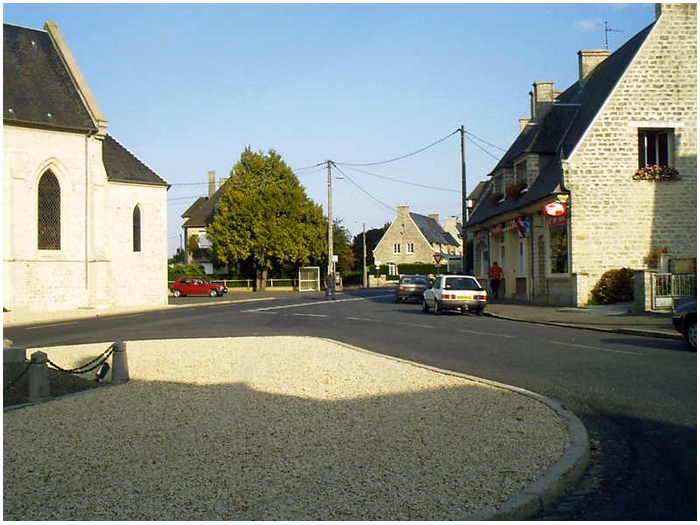
For a short while a silence fell over Lingèvres, but around 16.15 hours, a message was received
that German tanks were spotted west of the village, on the D13 from Balleroy. Harris moved his
Firefly to a new position, while Captain John Stirling with his Sherman positioned himself 500
meters to the north-west.
Because he covered the flank he managed to destroy a Panther. Harris had found a perfect spot for
an ambush and just waited for the German tanks to emerge. On a small road on the left side of the
D13 the complete D13 leading into the village could be observed. Because of the houses, the Germans
were unable to see Harris his tank. The first Panther was put out of action before it reached the
outskirts of the village. The second rumbled pass the destroyed Panther, and was also hit by Harris.
The sprocket of the tracks was damaged, but the Panther managed to reach the centre of Lingèvres.
But there, the crew had to abandon their crippled tank.
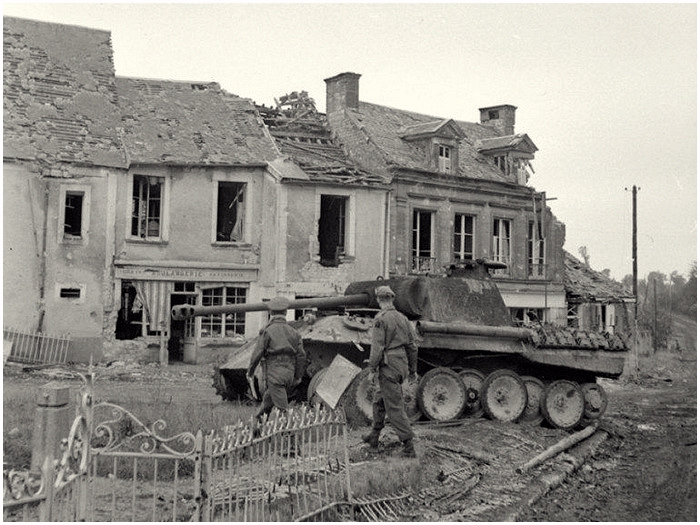
The crippled Panther in the centre of Lingèvres
(left, just outside the picture, stands the Sherman of Lt. Morrison)
Below, the situation today
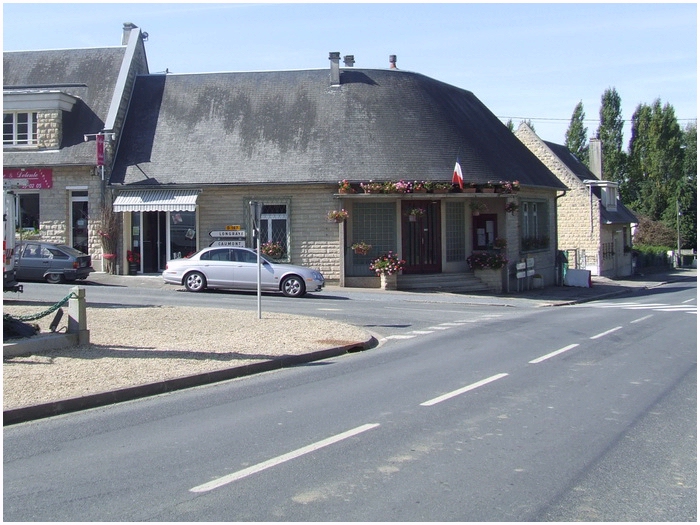
A third Panther tried his luck, but was shot upo bij the 17 pounder of the Firefly when it passed
the first destroyed one. After this, the German counter attacks stopped to retake Lingèvres. A total
of nine German tanks were put out of action by the Durham Light Infantry anti-tank weapons and their
tank support. Five of these tanks were for the Firefly of Harris and the marksmanship of Mackillop
who needed only five shells for five Panthers.
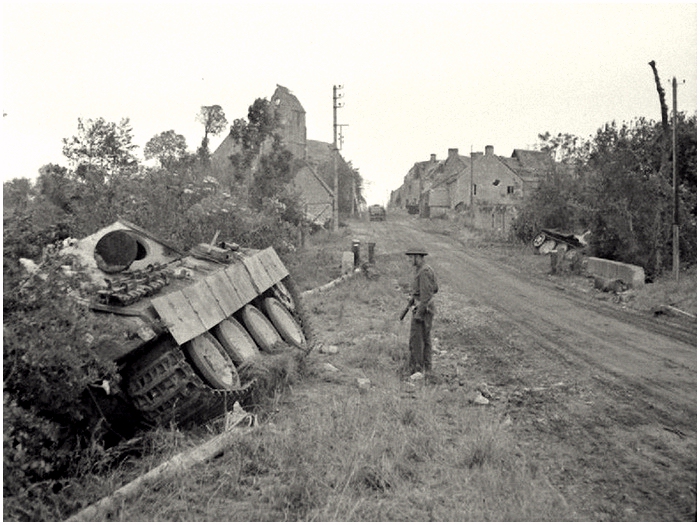
Two of the destroyed Panther tanks which were stopped by
the Firefly from Harris
The situation today, from a Panther is no trace to be found anymore
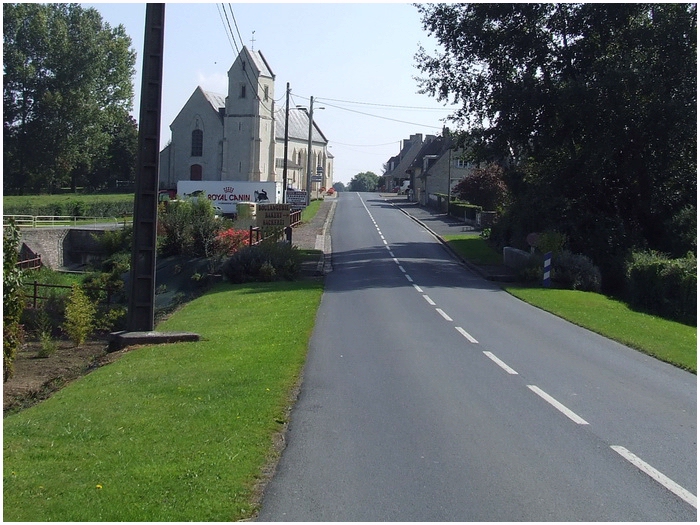
Lingèvres stayed in hands of the 9th DLI . They were relieved later in the evening by the 2nd
Glosters of the 56th Infantry Brigade. Of the 590 men who went into battle that day, 22 officers and
226 other ranks were killed, wounded or missing. The 6th DLI also held their position at les Verrières,
but had to retreat in the night. Their losses were also heavy, a 100 men were killed, wounded or missing.
Five supporting tanks of B Squadron of the 4th/7th Dragoon Guards were lost and 17 crewmembers were killed.
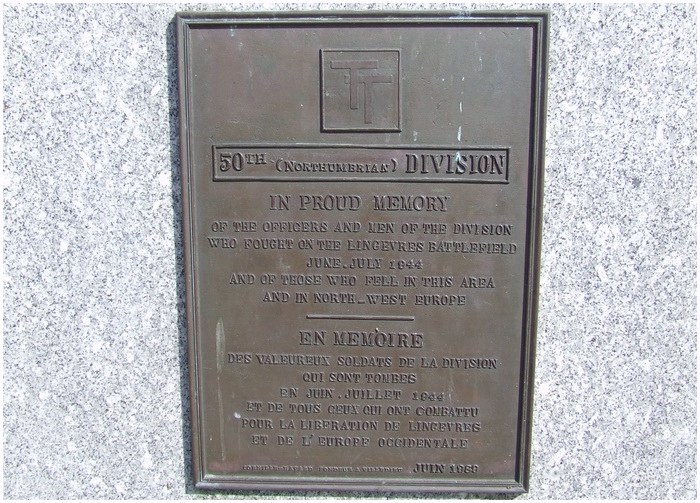
A plaque at the church remembers the battle
for Lingèvres
While the fighting around the D13 took place on 14 June, the 7th Armoured Division, which had
made a big hook towards Caen, had suffered great losses the day before. On 13 June in Villers-Bocage
they had run into an Abteilung of Tigers. To continue this tour and head for Villers-Bocage,
leave Lingèvres westwards via the D13 towards St. Paul-du-Vernay. After 1.5 kilometres, near La Belle
Epine, go left on the D67A. If you miss this, go to St. Paul-du-Vernay and go there left on the D99.
Both roads lead to Cahagnolles.
For the tour towards Villers-Bocage click below
|